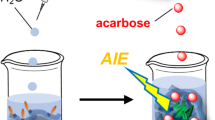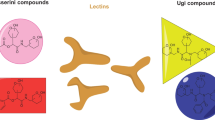Abstract
In this study, an improved, rapid, high yield synthesis of N,N’-4,4’-bis(benzyl-2-boronic acid)-bipyridinium dibromide (o-BBV) is described. The obtained o-BVV is applied in a two-component saccharide sensing system (complex) where it serves as a fluorescence quencher and a saccharide receptor. This system was applied to different natural oligosaccharides isolated from molluscan Rapana venosa (RvH1-a) and arthropodan Carcinus aestuarii (CaeH) hemocyanins (Hcs) and cyclodextrins (CDs). The carbohydrate contents of both Hcs were calculated in our previous work to be 1,6 % and 7 % for CaeH and RvH1-a, respectively. We propose that the difference in fluorescence increase of the native CaeH and RvH1-a when titrating them with the complex is due to the fact that the carbohydrate content of CaeH is lower and the carbohydrate chains are buried in between the structural subunits of the native molecule, while the glycans of the functional unit RvH1-a are exposed on the surface of the molecule leading to a 4-fold fluorescence’s intensity change.








Similar content being viewed by others
References
Geddes CD, Lakowicz JR (2006) Topics in fluorescence spectroscopy. Springer, New York, pp 344–350
Suzuki I, Yamauchi A, Sakashita Y, Hirose K, Miura T, Hayashita T (2007) Fluorescence response mechanism of D-glucose selectivity for supramolecular probes composed of phenylboronic-acid-modified β-cycloextrin and styrylpyridinium dyes. Anal Sci 23:1167–1171
James TD, Linnane P, Shinkai S (1996) Fluorescent saccharide receptors: a sweet solution to the design, assembly and evaluation of boronic acid derived PET sensors. Chem Commun 3:281–288
Badugu R, Lakowicz JR, Geddes CD (2005) Boronic acid fluorescent sensors for monosaccharide signaling based on the 6-methoxyquinolinium heterocyclic nucleus: progress toward noninvasive and continuous glucose monitoring. Bioorg Med Chem 13:113–119
Badugu R, Lakowicz JR, Geddes CD (2004) Noninvasive continuous monitoring of physiological glucose using a monosaccharide-sensing contact lens. Anal Chem 76:610–618
Cao H, McGill T, Heagy MD (2004) Substituent effects on monoboronic acid sensors for saccharides based on N-phenyl-1,8naphthalenedicarboximides. J Org Chem 69:2959–2966
Cordes DB, Gamsey S, Sharrett Z, Miller A, Thoniyot P, Wessling RA, Singaram B (2005) The interaction of boronic acid-substitued viologens with pyranine: the effects of quencher charge on fluorescence quenching and glucose response. Langmuir 21:6540–6547
Zhang Y, Gao Z, Hardcastle K, Wang B, Zhang Y, Gao Z, Hardcastle K, Wang B (2006) Water-soluble fluorescent boronic acid compounds for saccharide sensing: substituent effects on their fluorescence properties. Chem Eur J 12:1377–1384
Jiang S, Escobedo JO, Kim KK, Alptürk O, Samoei GF, Fakayode SO, Warner IM, Rusin O, Strongin RM (2006) Stereochemical and regiochemical trends in the selective detection of saccharides. J Am Chem Soc 128:12221–12228
Tan W, Zhang D, Wg Z, Li C, Zhu D (2007) 4-(N, N dimethylamine)benzonitrile (DMABN) derivatives with boronic acid and boronate groups: new fluorescent sensors for saccharides and fluoride ion. J Mater Chem 17:1964–1968
Camara JN, Suri JT, Cappuccio FE, Wessling RA, Singaram B (2002) Boronic acid substituted viologen based optical sugar sensors: modulated quenching with viologen as a method for monosaccharide detection. Tetrahedron Lett 43:1139–1141
Arimori S, Ward CJ, James TD (2002) A d-glucose selective fluorescent assay. Tetrahedron Lett 43:303–305
Wiskur SL, Ait-Haddou H, Lavigne JJ, Ansyln EV (2001) Teaching old indicators new tricks. Acc Chem Res 34:963–972
Arimori S, Murakami H, Takeuchi M, Shinkai S (1995) Sugar-controlled association and photoinduced electron-transfer in boronic-acid-appended porphyrins. Chem Commun :961–962
DiCesare N, Pinto MR, Schanze KS, Lakowicz JR (2002) Saccharide detection based on the amplified fluorescence quenching of a water-soluble poly(phenylene ethynylene) by a boronic acid functionalized benzyl viologen derivative. Langmuir 18:7785–7787
Bender ML, Komiyama M (1978) Cyclodextrin chemistry. Springer, Berlin
Szejtli J (1988) Cyclodextrin technology. Kluwer Academic Publishers, The Netherlands
Szejtli J (1998) Introduction and general overview of cyclodextrrin chemistry. Chem Rev 98:1743–1753
Singh M, Sharma R, Banerjee UC (2002) Biotechnological applications of cyclodextrins. Biotechnol Adv 20:341–359
Szejtli J (1982) Cyclodextrins and their inclusion complexes. Akademiai Kiado, Budapest
Uekama K (2002) Recent aspects of pharmaceutical application of cyclodextrins. J Incl Phenom Macrocycl Chem 44:3–7
Fernandez M, Fragoso A, Cao R, Villalonga R (2005) Stabilization of α-chymotrypsin by chemical modification with monoamine cyclodextrin. Process Biochem 40:2091–2094
Lelievre F, Yan C, Zare RN, Gareil P (1996) Capillary electrochromatography: operating characteristics and enantiomeric separations. J Chromatogr A 723:145–156
Bhosale SV (2007) b-Cyclodextrin as supramolecular catalyst in organic synthesis. Synlett 1:175–176
Blach P, Landy D, Fourmentin S, Surpateanu G, Bricout H, Ponchel A, Hapiot F, Monflier E (2005) Sulfobutyl ether-β-cyclodextrins: promising supramolecular carriers for aqueous organometallic catalysis. Adv Synth Catal 347:1301–1307
Szente L, Szejtli J (2004) Cyclodextrins as food ingredients. Trends Food Sci Technol 15:137–142
Fourmentin S, Outirite M, Blach P, Landy D, Ponchel A, Monflier E, Surpateanu G (2007) Solubilisation of chlorinated solvents by cyclodextrin derivatives: a study by static headspace gas chromatography and molecular modeling. J Hazard Mater 141:92–97
Hattori K, Takeuchi T, Ogata M, Takanohashi A, Mikuni K, Nakanishi K, Imata H (2007) Detection of environmental chemicals by SPR assay using branched cyclodextrin as sensor ligand. J Incl Phenom Macrocycl Chem 57:339–342
Burmester T (2001) Molecular evolution of the arthropod hemocyanin superfamily. Mol Biol Evol 18:184–195
Dolashka-Angelova P, Dolashki A, Stevanovic S, Hristova R, Atanasov B, Nicolov P, Voelter W (2005) Structure and stability of arthropodan hemocyanin Limulus polyphemus. Spectrochim Acta 6:1207–1217
Gatsogiannis Ch, Markl J (2009) Keyhole limpet hemocyanin: 9-Å CryoEM structure and molecular model of the KLH1 didecamer reveal the interfaces and intricate topology of the 160 functional units. J Mol Biol 385:963–983
Dolashka-Angelova P, Schwarz H, Dolashki A, Stevanovic S, Fecker M, Saeed M, Voelter W (2003) Oligomeric stability of Rapana venosa hemocyanin (RvH) and its structural subunits. Biochim Biophys Acta 1646:77–85
Lieb B, Boisguérin V, Gebauer W, Markl J (2004) cDNA sequence, protein structure, and evolution of the single hemocyanin from Aplysia californica, an opisthobranch gastropod. J Mol Evol 59:536–545
Dolashka-Angelova P, Stevanovic S, Dolashki A, Devreese B, Tzvetkova B, Voelter W, Van Beeumen J, Salvato B (2007) A challenging insight on the structural unit 1 of molluscan Rapana venosa hemocyanin. Arch Biochem Biophys 459:50–58
Dolashka-Angelova P, Beltramini M, Dolashki A, Salvato B, Voelter W (2001) Carbohydrate composition of carcinus aestuarii hemocyanin. Biophys 389:153–158
Velkova L, Dolashka P, Lieb B, Dolashki A, Voelter W, Van Beeumen J, Devreese B (2011) Glycan structures of the structural subunit (HtH1) of Haliotis tuberculata hemocyanin. Glycoconj J 28:385–395
Wuhrer M, Robijn MLM, Koeleman CAM, Balog CIA, Geyer R, Deelder AM, Hokke CH (2004) A novel Gal(β1-4)Gal(β1-4)Fuc(α1-6)-core modification attached to the proximal N-acetylglucosamine of keyhole limpet haemocyanin (KLH) N-glycans. Biochem J 378:625–632
Dolashka P, Velkova L, Shishkov S, Kostova K, Dolashki A, Dimitrov I, Atanasov B, Devreese B, Voelter W, Beeumen V (2010) Glycan structures and antiviral effect of the structural subunit RvH2 of Rapana hemocyanin J. Carbohydr Res 345:2361–2367
Lommerse JP, Thomas-Oates JE, Gielens C, Préaux G, Kamerling JP, Vliegenthart JF (1997) Primary structure of 21 novel monoanntenary and diantennary N-linked carbohydrate chains from αD-hemocyanin from Helix pomatia. Eur J Biochem 249:195–222
Snyder HR, Reedy AJ, Lennarz WJ (1958) Synthesis of aromatic boronic acids. Aldehydo boronic acids and a boronic acid analog of tyrosine. J Am Chem Soc 80:835–838
Gamsey S, Miller A, Olmstead M, Beavers C, Hirayama L, Pradhan S, Wessling R, Singaram B (2007) Boronic acid-based bipyridinium salts as a tunable receptors for monosaccharides and α-hydroxycarboxylates. J Am Chem Soc 129:1278–1286
Cappuccio FE, Suri JT, Cordes DB, Wessling RA, Singaram B (2004) Evaluation of pyranine derivatives in boronic acid based saccharide sensing: significance of charge interaction between dye and quencher in solution and hydrogel. J of Fluoresc 14:521–533
Dolashka-Angelova P, Dolashki A, Savvides SN, Hristova R, Van Beeumen J, Voelter W, Devreese B, Weser U, Di Muro P, Salvato B, Stevanovic S (2005) Structure of Hemocyanin subunit CaeSS2 of the Crustacean meditarranean crab carcinus aestuarii. J Biochem 138:303–312
Dolashka-Angelova P, Beck A, Dolashki A, Beltramini M, Stevanovic S, Salvato B, Veolter W (2003) Characterization of the carbohydrate moieties of the functional unit RvH1-a of Rapana venosa haemocyanin using HPLC/electrospray ionization MSand glycosidase digestion. Biochem J 374:185–192
Acknowledgments
This work was supported by a research grant by 330 the Bulgarian National Science Fund TK01-496/2009 and DFG-STE 1819/5-1/2012 (Germany). P. Dolashka and E. Kostadinova thank to German Academic Exchange Service (DAAD) for financing this study.
Author information
Authors and Affiliations
Corresponding author
Rights and permissions
About this article
Cite this article
Kostadinova, E., Dolashka, P., Kaloyanova, S. et al. Method for Analysis of Different Oligosacchiride Structures. J Fluoresc 22, 1609–1615 (2012). https://doi.org/10.1007/s10895-012-1102-9
Received:
Accepted:
Published:
Issue Date:
DOI: https://doi.org/10.1007/s10895-012-1102-9




